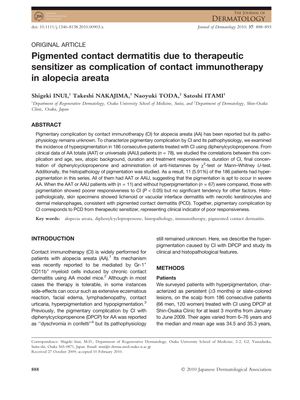TLDR Some patients with severe alopecia areata developed skin darkening from their treatment, which may indicate a less effective response to the therapy.
In a study of 186 patients treated with contact immunotherapy (CI) using diphenylcyclopropenone for alopecia areata (AA), 11 patients (5.91%) developed hyperpigmentation, all of whom had severe forms of AA, either totalis (AAT) or universalis (AAU). The study aimed to understand the incidence and pathophysiology of this pigmentary complication. A comparison between the 11 AAT or AAU patients with hyperpigmentation and the 67 without showed that those with pigmentation had a poorer response to CI (P < 0.05), although no significant correlations were found with age, sex, atopic background, duration of CI, final concentration of diphenylcyclopropenone, or administration of antihistamines. Histopathological examination revealed that the pigmentation was consistent with pigmented contact dermatitis (PCD), caused by the therapeutic sensitizer, and it was suggested to be an indicator of poor responsiveness to CI treatment.
35 citations
,
August 2009 in “Journal of the American Academy of Dermatology” Melanocytes might be targeted by the immune system in people with alopecia areata, but more research is needed.
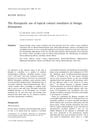 23 citations
,
July 2008 in “British journal of dermatology/British journal of dermatology, Supplement”
23 citations
,
July 2008 in “British journal of dermatology/British journal of dermatology, Supplement” Topical contact sensitizers can treat certain skin conditions but are rarely used in the U.K.
84 citations
,
October 2007 in “The Journal of Immunology” Myeloid-derived suppressor cells help control autoimmune cells and promote hair regrowth in alopecia areata.
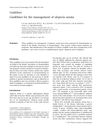 182 citations
,
October 2003 in “British Journal of Dermatology”
182 citations
,
October 2003 in “British Journal of Dermatology” The 2003 guidelines suggest that while some treatments can regrow hair in alopecia areata, none alter the disease's progression, and wigs may be the best option for extensive hair loss.
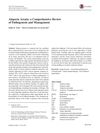 99 citations
,
July 2017 in “Clinical Reviews in Allergy & Immunology”
99 citations
,
July 2017 in “Clinical Reviews in Allergy & Immunology” New treatments for Alopecia Areata show promise but need to be more effective and affordable.
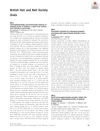 July 2018 in “British Journal of Dermatology”
July 2018 in “British Journal of Dermatology” Hair regrowth was seen in 83% of children with alopecia, immune system plays a role in the condition, and various treatments showed effectiveness for hair and nail disorders.
37 citations
,
December 2021 in “Cells” Alopecia areata severity and treatment response are linked to specific cytokine levels.
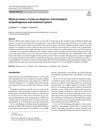 56 citations
,
January 2021 in “Clinical and Experimental Medicine”
56 citations
,
January 2021 in “Clinical and Experimental Medicine” The document concludes that while there are various treatments for Alopecia Areata, there is no cure, and individualized treatment plans are essential due to varying effectiveness.
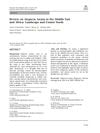 June 2023 in “Dermatology and therapy”
June 2023 in “Dermatology and therapy” The Middle East and Africa need better data, treatment consensus, and support for Alopecia Areata.
290 citations
,
August 2021 in “Clinical Reviews in Allergy & Immunology” JAK inhibitors show promise for treating alopecia areata, but more research is needed.
